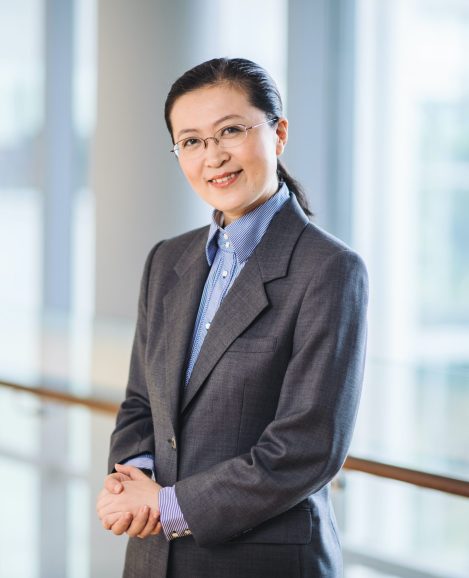




Team

Bin LIU
Director of NUS Flagship Green Energy Programme
Professor
Provost’s Chair
Head of Department (Chemical & Biomolecular Engineering)
Vice President (Research and Technology), National University of Singapore
Deputy Editor for ACS Materials Letters (American Chemical Society)
Liu Bin is a leader in the field of organic functional materials, and well-recognised for her contributions in polymer chemistry and applications of organic nanomaterials for biomedical research, environmental monitoring and energy devices. She is named among the World’s Most Influential Minds and the Top 1% Highly Cited Researchers in Materials Science by Thomson Reuters and Clarivate Analytics since 2014.
She was appointed Vice President (Research and Technology) at the National University of Singapore (NUS) on 1 September 2019. She has been the Head of the Department of Chemical and Biomolecular Engineering since July 2017.
Liu Bin has an impressive list of accolades to her name and most recently she was awarded the prestigious 2019 American Chemical Society ACS Nano Lectureship Award, which honors three award recipients from around the world who have significantly impacted the fields of nanoscience and nanotechnology. On Feb 2019, she shared her insights with global thought leaders on tackling climate change through technological innovation at World Economic Forum Annual Meeting in Davos. She is passionate about nurturing the next generation research leaders and encouraging more women to pursue careers in science and engineering.
- PhD (Chem) National University of Singapore, 2001
- MSc & BSc (Chem) Nanjing University, 1998 & 1995
2014 – 2019 Top 1% Highly Cited Researchers in Materials Science
2019 ACS Nano Lectureship Award for Asia/Pacific
2018 NML Researcher Award
2017 Fellow, Asia-Pacific Academy of Materials
2017 Fellow, Singapore National Academy of Engineering
2016 President’s Science and Technology Awards
2016 Fellow, Royal Society of Chemistry
2013 NUS Young Researcher Award
2012 Faculty of Engineering Young Researcher Award, NUS
2011 L’Oréal Women in Science National Fellowship
2008 Singapore National Science and Technology Young Scientist Award
2006 Young Investigator Award, NUS
- Organic Functional Materials
- Luminescent Materials for Light Harvesting and Amplification
- Photocatalysis
- Nanoparticles
- Theranostics
- Conjugated polymers for visible-light-driven photocatalysis. Chunhui Dai, Bin Liu*. Energy Environ. Sci., 2020,13, 24-52. (https://doi.org/10.1039/C9EE01935A)
- A Cross-linked Conjugated Polymer Photosensitizer Enables Efficient Sunlight-Induced Photooxidation. Wenbo Wu, Shidang Xu, Guobin Qi, Han Zhu, Fang Hu, Zitong Liu, Deqing Zhang, Bin Liu* AngewandteChemie Int Ed, 2019, 58, 3062-3066 Special Issue: Women in Chemistry. (https://doi.org/10.1002/anie.201811067). Also featured in 18th International Symposium on Novel Aromatic Compounds (ISNA-18)
- Oxygen-assisted stabilization of single-atom Au during photocatalytic hydrogen evolution. Lei Zeng, Chunhui Dai, Bin Liu*, Can Xue. Journal of Materials Chemistry A, 2019,7, 24217-24221. (https://doi.org/10.1039/C9TA10290F) This article is part of the themed collection: International Year of the Periodic Table : Single Atoms as Active Catalysts
- Precise Molecular Design for High‐Performance Luminogens with Aggregation‐Induced Emission. Shidang Xu, Yukun Duan, Bin Liu* Advanced Materials, 2019, 32, 1903530. (https://doi.org/10.1002/adma.201903530). Also featured in Advanced Materials Hall of Fame
- Triphenylamine based conjugated microporous polymers for selective photoreduction of CO2 to CO under visible light. Chunhui Dai, Lixiang Zhong, Xuezhong Gong, Lei Zeng, Can Xue, Shuzhou Li, Bin Liu* Green Chemistry, 2019, 21, 6606-6610. (https://doi.org/10.1039/C9GC03131F)
- Dibenzothiophene-S,S-Dioxide-Based Conjugated Polymers: Highly Efficient Photocatalyts for Hydrogen Production from Water under Visible Light. Chunhui Dai, Shidang Xu, Wei Liu, Xuezhong Gong, Majid Panahandeh-Fard, Zitong Liu, Deqing Zhang, Can Xue, Kian Ping Loh, Bin Liu* Small, 2018, 14, 1801839. (https://doi.org/10.1002/smll.201801839).

